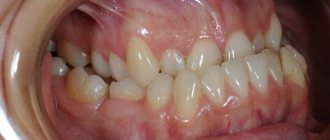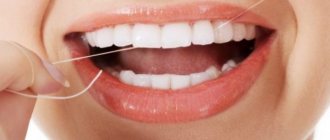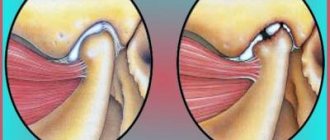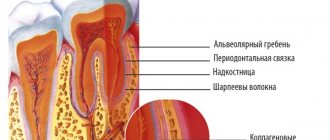Reasons for the development of micrognathia
Anomalies of jaw development can be congenital or acquired.
Congenital ones include:
- Severe acute illnesses of a woman during pregnancy,
- Anomalies of intrauterine development of the fetus,
- Congenital pathologies of the development of the dental system,
- Genetic predisposition.
An acquired anomaly can result from:
- Maxillofacial trauma,
- Artificial feeding and improper sucking in infancy,
- Diseases of the endocrine system,
- Past infectious diseases and inflammatory processes,
- Early loss of baby teeth,
- Problems with nasal breathing.
Problems that accompany the loss of chewing teeth
The absence of teeth primarily affects the inability to eat properly. If teeth are removed only on one side, then an increased load falls on the other, which means that the jaw joint is overloaded in a certain area, a crunch appears when the jaw moves, headaches develop, and over time, facial asymmetry may occur. If teeth are missing on only one jaw, then those located on the opposite jaw begin to shift, i.e. fall out of the sockets because they do not receive full support from the antagonist teeth. Naturally, bone tissue atrophy occurs in the area of missing teeth, which remains without the natural chewing load.
The absence of chewing teeth also entails aesthetic disturbances. Even if the defect is not noticeable when smiling, the cheeks become sunken and a large number of wrinkles form. Problems of the digestive tract also arise, especially if chewing teeth are missing on both sides at once - this is the result of inadequate and poor-quality chewing of food and a transition to softer foods.
Diagnosis and treatment of narrow jaw
Deformed dentition, crowded teeth, malocclusion, unerupted teeth are consequences of an underdeveloped dental system. The earlier these abnormalities are diagnosed, the more effective the treatment will be. To expand the lower and upper jaws, therapeutic methods, mechanical expanders and plates are used. In rare cases, only surgery helps.
In children under 10-11 years old, jaw expansion gives the best results. This is a time of active growth and formation of bone tissue, so the defect can be corrected with the help of orthodontic structures.
Which prosthetics are better for complete edentia?
Classic removable dentures are affordable, but they are not able to provide everything necessary for a high quality of life:
- functionality;
- comfort to wear;
- quality of chewing food;
- healthy load on the jaw;
- restoration of the natural shape of the face.
This is a half-measure that does not allow us to fully restore a decent quality of life. This is why dental implantation is the best solution for complete edentia. Computer modeling methods allow you to understand what your smile and overall face will look like even before implants and prostheses are installed. At the same time, computer programs help to accurately determine the location of future implants to restore the natural shape of the face, eliminate deep wrinkles, hollow lips and cheeks caused by missing teeth.
In case of complete absence of teeth, two concepts of implantological treatment are provided: classical and mini-implantation.
With mini-implantation, which is considered a temporary solution, the prosthesis is installed immediately after implantation. With mini-implantation, only removable prosthetics are available, and the design is inferior to classical prosthetics in terms of reliability and durability.
In the classic version, the patient undergoes the procedure of engrafting several implants - artificial roots made of titanium, which will serve as support for the future prosthesis. To securely attach the prosthesis, a minimum of 4 implants are required in the upper jaw and 3 in the lower jaw. But in a number of clinical cases, to achieve better stability, it is recommended to use a larger number of implants. After 6 months, when the implants have finally taken root, a permanent prosthesis is installed on them.
Expansion of the lower jaw
A narrow lower jaw, or microgenia, can be corrected in childhood with special devices - distractors. This is a device that gradually stretches the bones of the lower jaw. New bone and soft tissue grows at the site of the sprain. When installing a distractor, first increase the distance between the canines of the lower jaw. Every day the device allows you to increase the lower jaw by 1 mm. When the jaw is wide enough to accommodate tooth growth, the distractor is placed in place for at least two weeks to stabilize the sprain.
If you have a problem similar to that described in this article, be sure to contact our specialists. Don't diagnose yourself!
Why you should call us now:
- We will answer all your questions in 3 minutes
- Free consultation
- The average work experience of doctors is 12 years
- Convenient location of clinics
Single contact phone number: +7
Make an appointment
In adult patients, the lower jaw bones are fused and cannot be stretched, as in children. Therefore, to enlarge the lower jaw, the surgeon cuts the bone in several places with an ultrasonic knife. On the fourth day after surgery, an expansion device is installed. The first adjustment of the stretching is carried out by an orthodontist, then the patient himself controls the stretching process, which can take up to six months.
After expanding the lower jaw, braces are installed on the lower front teeth to correct the bite. Crowded teeth gradually occupy the resulting space.
The photo below shows a narrow jaw before and after expansion.
Causes of loss of chewing teeth
In childhood, the main reason for the loss of chewing teeth is the absence or death of their rudiments. There may also be hereditary or external factors that have a direct impact on the fetus even at the stage of formation of its entire skeletal system. Parents should very carefully monitor the health of their children’s baby teeth, because if timely treatment is not carried out, the consequences can be very dire – including the premature loss of permanent ones.
In adult patients, the main cause of early tooth loss is various dental problems: pulpitis or periodontitis, as well as diseases of periodontal tissues, which begin with inflammation of the gums - periodontitis, less often - periodontal disease. In addition, these diseases can develop against the background of hormonal or age-related changes, diabetes mellitus, and metabolic disorders in the body. Loss of chewing teeth can also occur due to trauma to the jaw system or after prolonged wear, for example, of bridges.
Why does bone tissue decrease when teeth are missing?
So, let's talk a little about the causes of bone loss.
One of the problems is the so-called bone deficiency. It is very important to understand that bone is the same living tissue of the body as all other organs, although it is very hard and has its own laws of life, growth time, etc.
The roots of the teeth are located in the bone of the alveolar process on the upper jaw and in the alveolar part on the lower jaw, they provide the retention and stability of the teeth. When we talk about bone deficiency, we mean the partial or complete absence of that bone tissue.
The alveolar bone has such a structure and structure that in the absence of teeth it simply dissolves or resorption occurs. Also, bone loss can occur with periodontal disease, even in the presence of teeth.
Removable dentures greatly increase the rate of alveolar bone resorption due to large or improper pressure on the gum and bone, pressure for which they were not designed.
All this can lead to the fact that there will be nowhere to place dental implants.
When one jaw is smaller than the other
If a person has one jaw smaller than the other, it is called micrognathia - congenital underdevelopment of the jaw bone. An anomaly occurs:
- top and bottom;
- symmetrical and asymmetrical;
- one- and two-sided;
- weakly or strongly expressed.
Signs of microgenia of the lower jaw in humans are difficult to miss: the distorted proportions of the face make it look like a bird’s head. The chin and lower lip tend to fall sharply. At the same time, the lower jaw is not very mobile, and it is difficult for a person to bite, chew and swallow food. Such patients often have a malocclusion.
With upper micrognathia, the upper jaw suffers - the teeth grow at an angle, and the lower ones are in front. Sometimes this causes a shift towards the lower jaw, which leads to facial asymmetry.
This pathology can have several causes:
- unbalanced diet of a pregnant woman;
- damage to the fetus in the womb;
- premature loss of baby or molar teeth;
- late change of bite from temporary to permanent;
- Robin's syndrome (defect of the maxillofacial region);
- endocrine diseases;
- impaired breathing through the nose;
- bad habits;
- heredity.
In addition to a reduced jaw, there is also an overly enlarged jaw. This pathology is called macrognathia. More often there are patients with an “overdeveloped” lower jaw, less often with an upper jaw, sometimes macrognathia is mixed.
With superior macrognathia, it is difficult for a person to bite and chew food, breathing and speech are impaired, and the middle part of the face protrudes sharply forward. This pathology occurs if a person has impaired nasal breathing.
Lower macrognathia occurs due to excessive development of the lower jaw and most often occurs in the fetus in the womb.
Missing teeth: health at risk
Edentia is the absence of teeth, which does not allow a person to live a full life. First of all, health problems arise not only in the oral cavity, but also in other areas.
Due to the disease, a person loses:
- bone and muscle tone;
- symmetry of the face and jaw;
- anatomically correct bite;
- the opportunity to eat well and much more.
The absence of one tooth, for example, on the top row gradually forces the “neighbors” to shift towards free space. There is a curvature of the entire dentition, the distribution of the chewing load changes, the destruction of bone tissue and its natural loss. If there is free space in the oral cavity for a long time and a person does not visit the dentist to correct the situation, the teeth develop pathological abrasion and hypersensitivity. And if you have lost more than 10-12 teeth in a row, you can easily develop subluxation of the lower jaw. In the case of complete edentia, the situation looks even more critical.
So what are the consequences of long-term absence of teeth in the oral cavity? Let's look at the example of your health.
Curvature and tooth decay
One tooth that you have lost entails a restructuring of the entire dentition. In free space, units move apart or turn around, sway and lose support in the neighborhood. All this leads to a change in bite, and then to problems with the maxillofacial joint. By the way, problems in this area can also affect the neck, head and back. You can get another not very pleasant disease in addition to problems in the oral cavity.
In addition, pieces of food may remain in the “voids” in the jaw. Microorganisms form in these accumulations, and then caries and inflammatory processes in the mouth form. So, in addition to truly crooked and loose teeth, you can get a number of soft tissue diseases.
Gum tissue is affected
Once the process of tooth decay begins, problems with the gums and soft tissues in the oral cavity follow. And soda solution will not help here! The epithelium (top layer) becomes thinner over time and may disappear almost completely. In this case, some experts recommend bone augmentation - not the most pleasant operation for the patient. It is done before installing implants and prostheses, however, the rehabilitation process after bone tissue augmentation takes up to six months.
And the affected soft tissues directly affect food intake. Difficulties in digestion aggravate the situation with the gums, resulting in a vicious circle.
Eating problems
The gastrointestinal tract is the next system in the body that is affected by adentia. Poor digestion of food and its poor absorption become the main problems for humans. The absence of teeth and chewing with the “gum” force you to change your diet towards liquid foods and a variety of purees. Chewing your favorite meat becomes increasingly difficult or even impossible. A complete transition to “soft” food provokes a problem associated with the functioning of the gastrointestinal tract. Gastritis, colitis and other unpleasant diseases occur.
Thus, from a health point of view, you lose not only your teeth, but also an elementary way to eat normally, eat your favorite foods and constantly control yourself in taste preferences. Unpleasant sensations in the oral cavity, diseases of soft tissues after treatment can occur again and again until the problem is radically solved - installing a fixed prosthesis. All-on-4 technology allows you to get your teeth back in 1 day and correct all the health problems that the patient developed while delaying his treatment.
Want to know how? Call the hotline of the Teeth in 1 Day clinic network and we will tell you all the details about the fixed prosthetics system!
Micrognathia and macrognathia: treatment
Since a child is often born with this anomaly, doctors recommend using special pacifiers and nipples in the first year of life.
For the treatment of micrognathia and macrognathia in adults, different orthodontic structures are used:
- Katz guide crown;
- chin sling;
- corrective mouthguards;
- special plate with a pull-out.
If treatment with this method does not produce results, surgical intervention is possible: the bone is cut and reconnected, the jaw is fixed with a splint so that the bones grow together correctly. This operation can be performed by either a surgeon or an orthodontist. Some dental clinics are engaged in correcting underdevelopment of the lower jaw and other pathologies described above.
The iOrtho clinic network provides high-quality services for correcting malocclusion with Invisalign aligners, sign up for a consultation now!









